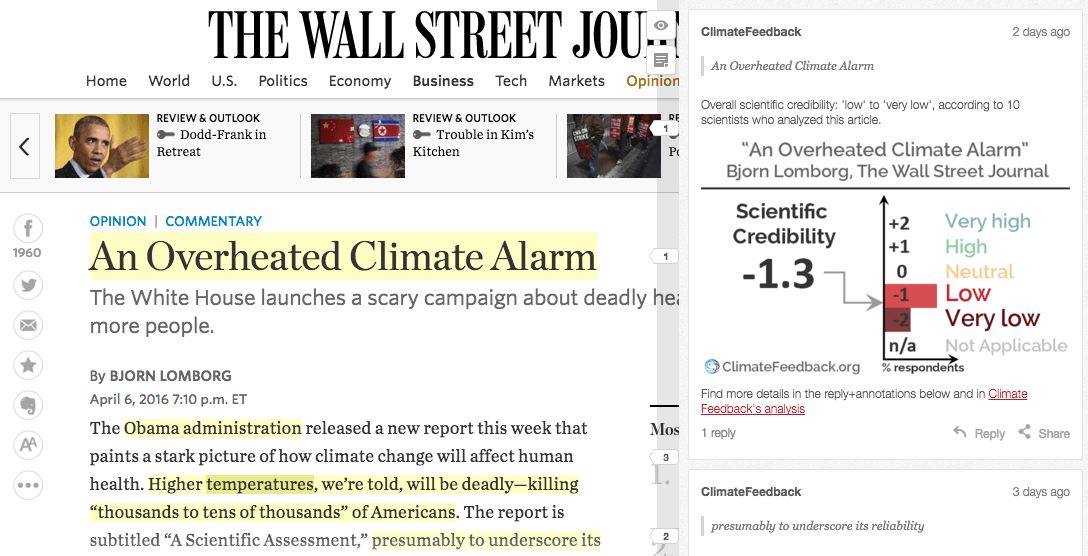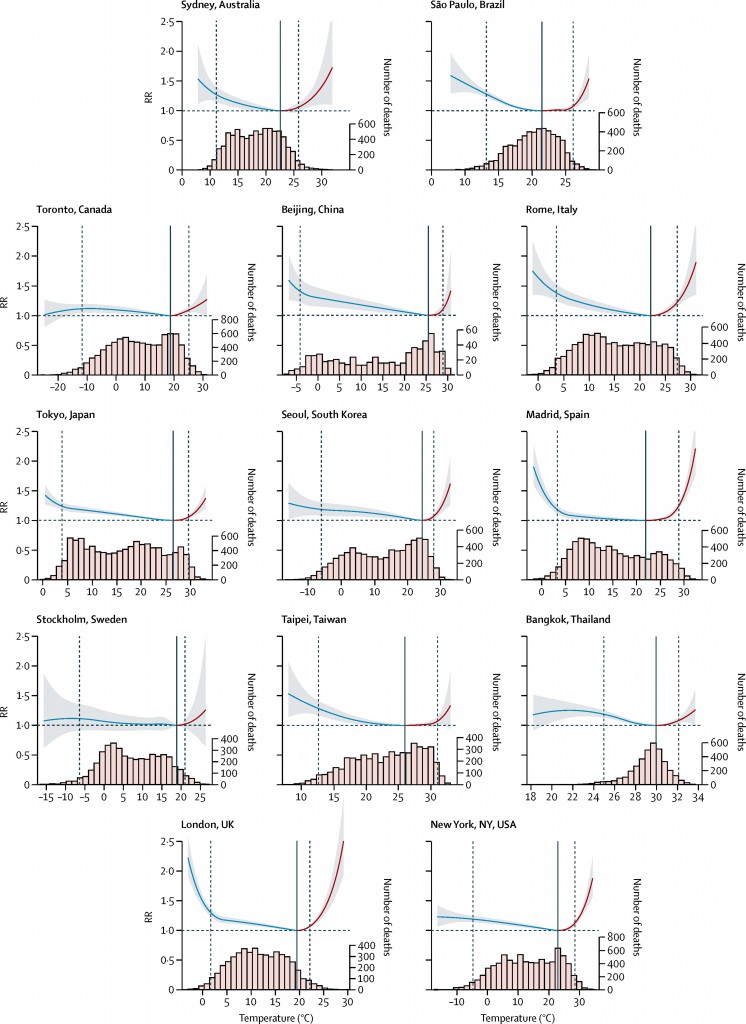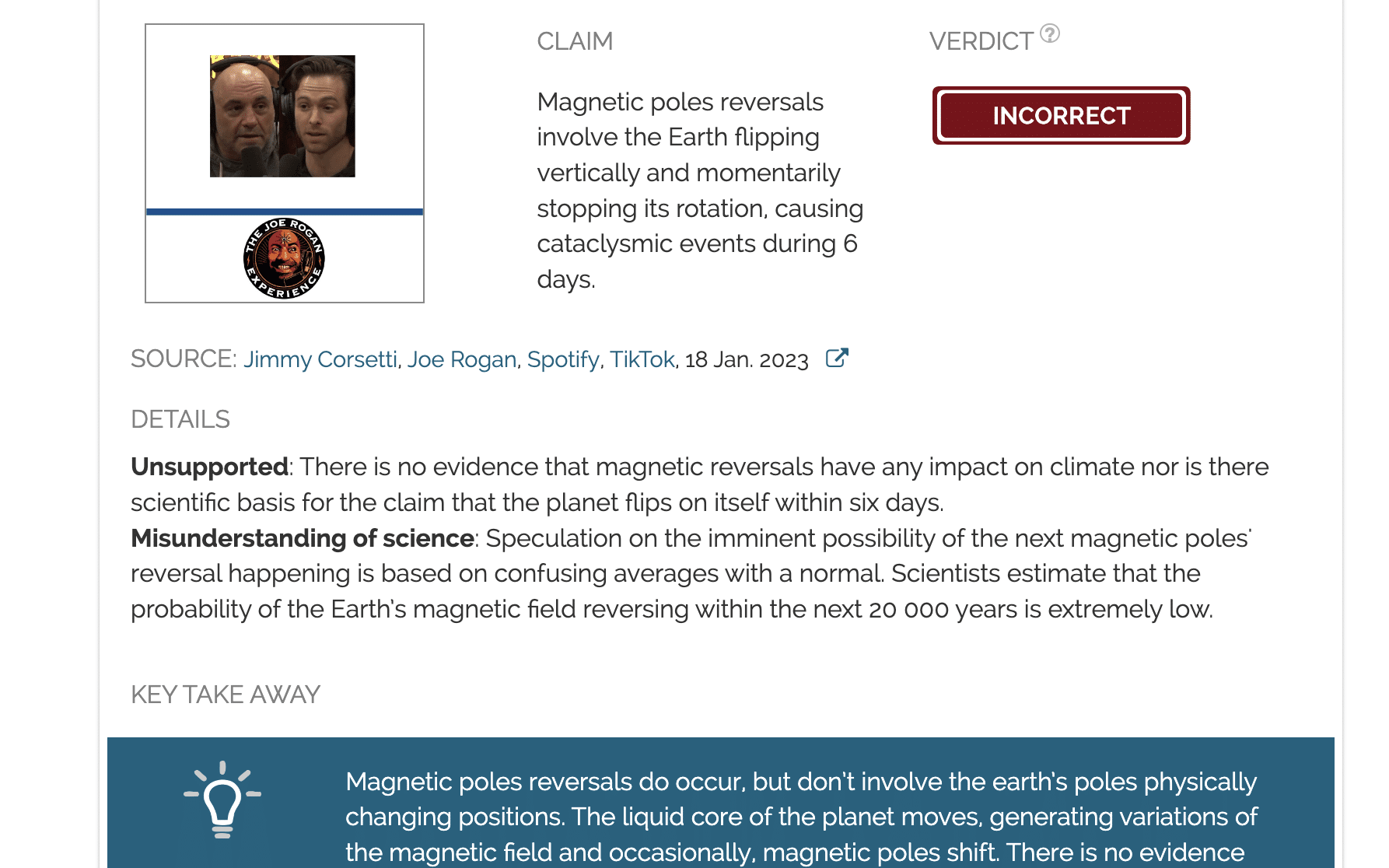- Climate
Analysis of "An Overheated Climate Alarm"
Reviewed content

Published in The Wall Street Journal, by Bjorn Lomborg, on 2016-04-06.

Scientists’ Feedback
SUMMARY
On 4 April 2016 the US Global Change Research Program released a comprehensive overview of the impact of climate change on American public health. In an op-ed in the Wall Street Journal, Bjorn Lomborg criticizes the report as unbalanced. Ten scientists analyzed the article and found that Lomborg had reached his conclusions through cherry-picking from a small subset of the evidence, misrepresenting the results of existing studies, and relying on flawed reasoning.
See all the scientists’ annotations in context
REVIEWERS’ OVERALL FEEDBACK
These comments are the overall opinion of scientists on the article, they are substantiated by their knowledge in the field and by the content of the analysis in the annotations on the article.

Associate Director of the Center for Health and the Global Environment, Boston Children’s Hospital, Harvard
While it’s true that cold may kill more people today than heat, Lomborg’s assertion that climate change will result in fewer overall deaths in the U.S. this century from extreme temperatures is not supported by available evidence. The citations in the report, which Lomborg himself dismisses, substantiate this claim e.g. Mills, David, et al. “Climate change impacts on extreme temperature mortality in select metropolitan areas in the United States” in Climatic Change.
Lomborg largely conflates U.S. with global assessments. His logic, from a public health perspective, is also deeply troubling and fails, at first pass, the maxim of “first do no harm”. Beyond this, adaptive capacity to climate extremes is no easy feat and as several past extreme heat events have shown, such as the European heatwaves of 2003 or 2010, the consequences reverberate beyond mortality in those directly exposed. Heatwaves promote wildfires, crop losses, food price spikes and conflicts.
My review is limited to the part of the article that describes the results of the study published in The Lancet, which I first-authored.
The interpretation provided in the article is misleading, as our study is meant to provide evidence on past/current relationships between temperature and health, and not to assess changes in the future. In addition, the study does not offer a global assessment, and it is limited to a set of countries not representative of the global population.
Bjorn Lomborg disputes the notion, presented in a recent national assessment report, that global warming will increase the number of temperature-related deaths in the US. To do so, he carefully picks studies and uses flawed reasoning.
Instances of faulty reasoning include Lomborg’s interpretations of the facts that i) cold-related deaths currently outnumber heat-related ones and ii) migration patterns in the last decades indicate that people are generally moving to the warmer, Southern part of the US. However, i) does not imply that warmer temperatures will reduce deaths: what matters is the sensitivity of the death-risk to a change in temperature, and that appears to be higher for heat than for cold; as for ii), migration patterns are not driven only by climate, and probably account for future climate change even less so.
While Mr. Lomborg’s single focus on deaths directly related to temperature could imply that it is the only thing that matters, it clouds out (whether on purpose or not) all the other impacts expected from global warming: impacts on ecosystems, agriculture, water resources, sea level rise, etc. Those other impacts are also expected to have detrimental effects, if not directly on the lives or deaths of Americans, at least on their welfare and on America’s prosperity.
Mr Lomborg points to a skewed and highly selective sample of the literature and ignores many other well-established findings that would undermine his argument. For example, the article ignores the recent finding that economic productivity declines with increasing temperatures past a fairly cool inflection point, and that this relationship remains unchanged even after considerable time for adaptation has elapsed. The article also ignores the adverse effects of climate change on agricultural production; the demonstrable relationship between heat and migration; the association between heat and interpersonal violence at all scales; the fact that unmitigated climate change will eventually make parts of the planet uninhabitable due to the increase of temperatures beyond the life-threatening threshold of 35C (wet bulb temperature, not dry temperature). Bizarrely, for an article concerned with the health effects of climate change, Mr Lomborg also fails to mention the demonstrable health benefits that are associated with cutting carbon emissions due to a reduction in pollution-related mortality. Unfortunately, therefore, the article fails to inform but instead misleads the readership by an extremely selective reporting of the literature.

Professor, University of New South Wales
The article raises legitimate issues but its key point that cold kills more people than heat is misleading, because heat deaths will skyrocket once global temperature has risen significantly while the benefits on the cold side will decline. Indeed there is a strict limit to human tolerance of heat and humidity, that may be approached in some regions within a century and would cause severe stresses.

Lecturer/Visiting Scholar, The Open University, Xi’an Jiaotong-Liverpool University
Lomborg is using scientific ‘language’ to suggest that climate change will have insignificant health impacts; this goes against a vast body of evidence. The notion that benefits from warmer winters could be more important than risks from hotter summers in terms of human health is plain wrong.
For once, the US administration is taking health impacts of climate change seriously, and it is particularly unhelpful to attempt to confuse the public on this issue.

Managing Analyst, Stratus Consulting
The article claims the new U.S. Global Change report overlooks the evidence about the relative significance of mortality attributed to cold (and the cold season) relative to heat (and the hot season) while in reality, it is included (see Sections 2.5 and 2.6). Similarly, Lomborg uses selective representation of published literature and puts the emphasis on studies outside the U.S., while the new report specifically notes it focuses on reviewing U.S. based studies.
This article is cherry-picking and presents scientific results in a misleading way.

Senior scientist, The Norwegian Meteorological institute
I think the article misrepresents statistics and cherry picks some facts to support its position while ignoring relevant ones. There may be some validity in some of the points. Overall, the message is very dubious. For the interested reader, here is an insightful discussion on the topic of how climate change threatens U.S. population’s health.

Professor, The University of British Columbia
The article is selective in its interpretation of the temperature-mortality relationship. It is correct that both cold and warm temperatures kill and that, at present, cold kills more than heat but that does not imply that future warming will lead to fewer cold-related deaths than any increase in heat-related deaths, these relationships are complex and non-linear. It also discusses one part only of a comprehensive assessment to argue that the whole assessment is incorrect/invalid. This is biased.
Notes:
[1] See the rating guidelines used for article evaluations.
[2] Each evaluation is independent. Scientists’ comments are all published at the same time.
Key Take-aways
The statements quoted below are from Bjorn Lomborg; comments and replies are from the reviewers.
“Higher temperatures, we’re told, will be deadly—killing “thousands to tens of thousands” of Americans”
Whether this is on purpose or not, Mr. Lomborg’s immediate focus on the part of the report dealing with temperature-related deaths makes it sound as if this is the only focus of the report. However, the report also deals with air quality impacts, food safety, extreme events, etc.
“cold kills many more people than heat.”

Professor, University of Washington
Mr. Lomborg is confusing seasonal mortality with temperature-related mortality. It is true that mortality is higher during winter than summer. However, it does not follow that winter mortality is temperature-dependent (which summer mortality is). Dave Mills and I reviewed the evidence and concluded that only a small proportion of winter mortality is likely associated with temperature. A growing numbers of publications are exploring associations between weather and winter mortality, with differences in methods and results. The country with the strongest association between winter mortality and temperature is England, which appears in other publications to be at least partly due to cold housing. Winter mortality is lower in northern European countries.

Senior scientist, The Norwegian Meteorological institute
This is cherry picking – even if it were true. Climate change is much more than just temperature. It also affects precipitation and the lack thereof – with consequences such as floods, mud slides, droughts, and wildfires.
Furthermore, the cold is fairly limited to the high northern latitudes, … and not so many live there, but many more in the warm tropics… These rich countries also have the means to collect statistics. The poor developing countries often lack credible statistics, and I do not believe for a second that we have an estimate of all people who die from heat stress in Asia, Africa, and Latin America.

Lecturer/Visiting Scholar, The Open University, Xi’an Jiaotong-Liverpool University
Lomborg seems unaware of, or more likely is ignoring, the fact that climate change caused by human activities is making the climate not only warmer but more unpredictable: increased intensity and frequency of extreme weather events including drought, heavy downpours, heat waves…
“In pushing too hard for the case that global warming is universally bad for everything, the administration’s report undermines the reasonable case for climate action.”
As seems to always be the case with Lomborg (cf his previous WSJ’s article reviewed by Climate Feedback), he picks up a few studies that support his position.
Note, first, that the report’s claim about projected heat-related deaths outweighing cold ones applies to the US: different regions might have different responses…
Second, when reviewing the literature on the topic, the IPCC report indicates (WGIIAR5-Chap11, p.721): “it is not clear whether winter mortality will decrease in a warmer, but more variable, climate (Kinney et al., 2012; Ebi and Mills, 2013). Overall, we conclude that the increase in heat-related mortality by mid-century will outweigh gains due to fewer cold periods, especially in tropical developing countries with limited adaptive capacities and large exposed populations”
So the US report does not appear wildly at odds with the literature on the topic, or to be “pushing too hard”. Also, it does not say that warming is universally bad, just that the bad outweighs the good on this particular topic.
“…climate change will also reduce the number of cold days and cold spells. That will cut the total number of cold-related deaths.”

Lecturer/Visiting Scholar, The Open University, Xi’an Jiaotong-Liverpool University
The assertion that warmer winters = less mortality is a schoolboy error. Indeed everyone knows that European countries with warmer climates and milder winters actually have MORE not LESS winter mortality; principally due to adaptation.
The current numbers of winter mortality may well be higher than summer heat wave mortality in many temperate to northern countries, however what is crucially important is that evidence points to significant increase in summer heat related mortality and no or very little change to winter mortality as a result of climate change.
A recent paper by Kinney et al. (Winter season mortality: will climate warming bring benefits?) suggests that reductions in cold-related mortality under warming climate may be much smaller than some have assumed. Kinney and colleagues analyzed excess winter mortality across multiple cities and over multiple years within individual cities. They found that excess winter mortality was no lower in warmer vs. colder cities, suggesting that temperature is not a key driver of winter excess mortality. In addition, variability in daily mortality within cities was not strongly influenced by winter temperature.

Professor, University of Washington
There is very limited scientific support for the claim that reducing the number of cold days (by which he apparently means winter) will reduce the number of cold-related deaths. Again, this is assuming winter mortality is temperature-dependent; an assumption not verified by research in the US and elsewhere.
“The administration’s new report refers to this study … but only in trivial ways, such as to establish the relationship between temperature and mortality.”
As previously noted, [our] study contributes evidence only to ‘direct’ effects of temperature on human health. As a matter of fact, this is likely to represent a minor part of the total excess mortality and morbidity due to a changing climate.
“Not once does this “scientific assessment” acknowledge that cold deaths significantly outweigh heat deaths.”
That’s not true. Under section 2.5, the report indicates:
“A recent analysis of U.S. deaths from temperature extremes based on death records found an average of approximately 1,300 deaths per year from 2006 to 2010 coded as resulting from extreme cold exposures, and 670 deaths per year coded as resulting from exposure to extreme heat. These results, and those from all similar studies that rely solely on coding within medical records to determine cause of deaths, will underestimate the actual number of deaths due to extreme temperatures.”
And then further down (my emphasis): “studies based on statistical approaches have found that, despite a larger number of deaths being coded as related to extreme cold rather than extreme heat, and a larger mortality rate in winter overall, the relationship between mortality and an additional day of extreme heat is generally much larger than the relationship between mortality and an additional day of extreme cold.”
“Consider a rigorous study published last year in the journal Lancet that examined temperature-related mortality around the globe.”
As the first author of this article, I deem it is worth pointing out that the aim of this study is to establish the association between non-optimal temperature and mortality (in terms of excess deaths) in the recent past, using historical data. The article clearly acknowledges that these results cannot be easily extrapolated to the future, in particular under climate change scenarios, for a series of reasons detailed in the discussion section of the article. For instance, the change in heat and cold-related deaths will depend on changes in future temperature distribution, which is likely to be more complex than a simple upward shift.
“The report confidently claims that when temperatures rise, “the reduction in premature deaths from cold are expected to be smaller than the increase in deaths from heat in the United States.” Six footnotes are attached to that statement.”
The report says “The decrease in deaths and illness due to reductions in winter cold have not been as well studied as the health impacts of increased heat, but the reduction in premature deaths from cold are expected to be smaller than the increase in deaths from heat in the United States“. This doesn’t sound over-confident to me; and as for the “footnotes”, there are scientific references to back up that claim, not asterisks leading to fine-print caveats…
“In the U.S. about 9,000 people die from heat each year but 144,000 die from cold.”
These numbers are not deaths reported as clinically due to heat or cold. It seems Lomborg computed them from the Lancet study, using percentages given by the study, times the total number of deaths.

Professor, University of Washington
Where do these numbers come from? According to a review of national health statistics:
During 2006–2010, about 2,000 U.S. residents died each year from weather-related causes. About 31% of these deaths were attributed to exposure to excessive natural heat, heat stroke, sun stroke, or all; 63% were attributed to exposure to excessive natural cold, hypothermia, or both; and the remaining 6% were attributed to floods, storms, or lightning.
This statement also confuses seasonal mortality with mortality from extreme events. As noted in Ebi and Mills, this distinction is important for understanding what could happen with climate change.

Lecturer/Visiting Scholar, The Open University, Xi’an Jiaotong-Liverpool University
In the UK for example, the evidence now shows NO strong link between how cold a winter is and how many deaths occur. Sure the link was very strong up until the 1970s, but Lomborg might be aware that since the 1950s there have been massive improvements in building, heating, aid to the poorest, healthcare. How winter temperatures affected mortality in the 50s is no longer relevant.
The key driver for annual variation in winter mortality in rich countries now appears to be incidence and virulence of influenza and similar diseases.
As previously noted, the study published in The Lancet contributes little to understanding how these figures will change in the future under scenarios of climate change. In particular, it is difficult to ascertain from these results if the supposed decrease in cold-related deaths will offset the supposed increase in heat-related mortality.
“cold deaths actually occur during moderate temperatures”

Senior scientist, The Norwegian Meteorological institute
This suggests that the dependency is not linear, and there is a multitude of factors involved. Hence, “cold deaths” may be a misnomer. The temperature is a moderator combined with standard of living, life-style diseases, pollution, and poverty, in addition to accidents and other weather conditions…
“The Lancet researchers found that about 0.5%—half a percent—of all deaths are associated with heat, not only from acute problems like heat stroke, but also increased mortality from cardiac events and dehydration. But more than 7% of deaths are related to cold—counting hypothermia, as well as increased blood pressure and risk of heart attack that results when the body restricts blood flow in response to frigid temperatures.”
I do not want to question the quality of this particular study, but it’s worth looking at how they get such numbers.
First, this is a statistical study where they look at data on numbers of deaths and temperatures in various locations: of course, nothing says if, or how, these deaths are really related to temperature (heat or cold). This is an empirical study. Lomborg’s comments suggest that the authors of this study are counting deaths explicitly caused by heat or cold, but this is not the case.
Second, they basically fit a temperature-death risk response curve to this data. They then see for what temperature the mortality risk is lowest – and then they aggregate all the deaths below (for cold-related deaths) and above (for heat-related ones) that temperature. Because the temperature of minimum mortality is often high (around 20-25C, or lower 70’s F), for cold-related deaths this leads to integrating the response function (even with low death risks) over much of the temperature distribution. See plots below. The authors indicate as much: “This difference was mainly caused by the high minimum-mortality percentile, with most of the mean daily temperatures being lower than the optimum value.” This methodology also explains why most cold-related deaths appear due to “moderate cold”.
This is worth explaining, because I am not sure dying in 15C weather (60F) in Rome or Sydney is really what people will understand when they read about “cold-related deaths”!
From Gasparrini et al. figure 1: Exposure–response associations as best linear unbiased prediction (with 95% empirical CI, shaded grey) in representative cities of the 13 countries, with related temperature distributions. Solid grey lines are minimum mortality temperatures and dashed grey lines are the 2.5th and 97.5th percentiles. RR=relative risk.
The other thing that is easy to see is that the risk curve generally increases slowly towards cold temperature, but a lot more steeply past high temperatures. So even if one agrees with how this study classifies and counts “cold deaths”, the fact that they outnumber heat deaths, in absolute numbers, does not necessarily mean that increasing temperatures will reduce deaths: based on these plots, it could well be that warming will reduce cold-related deaths less than it increases heat-related ones. And indeed, this is what the studies about future projection of temperature-related deaths that they cite, and that Lomborg discusses, do find.
“Consider where they move. Migration patterns show people heading for warm states like Texas and Florida, not snowy Minnesota and Michigan.”
This focuses on average climate rather than on extremes, and such patterns of migration are based on our knowledge of the past. As the frequency of extreme hot days increases, as the number of extreme hurricanes increases, and as sea levels rise, people may find that Florida is not so attractive after all.
People don’t like the cold, they like sunshine and warmth, and (supposedly as a result, according to Lomborg), they move to the South: does Lomborg really want us to deduce from that that global warming will thus be good for us – even simply in terms of temperature-related deaths?
That’s not reasonable.
First, while people have indeed generally been moving from the North(-East) to the South over the last decades, it’s not only because of “better climate”: quoting this article by the Washington Post, “Several long-term trends dating as far back as the 1960s are behind this larger pattern. The rise of air conditioning and interstate highways have made once-sleepy (and sweltering) Southern cities more appealing. And, over the same time, the decline of industrial jobs in the Midwest and Northeast have pushed people out. Cheap housing during the boom years also drove growth in states such as Arizona and Nevada“. I think that is already much more reasonable than saying that people move South only because they know they are less likely to die from cold exposure there.
Second, people may be moving there right now partly because of climate, and that may indeed be a “smart” move because, TODAY, indeed, current cold-related deaths outnumber heat-related deaths. However, even supposing that this is a significant factor in their decision process, it’s not clear that they are also thinking about future warming. So the fact that people are moving there NOW does not even logically imply, as Lomborg would have it, that FUTURE warming will be beneficial – which is the point of interest here.

Professor, University of Washington
This has more to do with economic factors than weather. If people moved only because of poor weather, why hasn’t everyone left Northern Europe?





